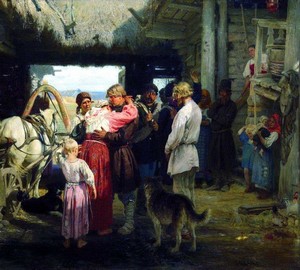
Description of the picture:
Seeing the rookie – Ilya Efimovich Repin. 1879. Oil on canvas. One hundred forty three x two hundred twenty five cm
Ilya Repin has a lot of bright original paintings that interest and delight us so far. The painter has always been in search of interesting subjects, talking images and interesting scenery. That is why in his works there is always an integral narrative that helpfully unfolds in front of his audience.
In 1878, the painter and his family moved to Moscow, and a year later Repin finished the painting “Seeing Off the Recruit”, which was a multi-figure composition. The idea of work comes to the painter in Abramtsevo, where his close friend, philanthropist Savva Mamontov lived. Walking around the neighborhood, the attentive gaze of Ilya Efimovich continually grabbed pictures of rural life.
In this picture, the author captured a remarkable action – the family and neighbors escort the young guy to serve in the army. The center of the canvas is the main character, a young recruit. The culmination of the work Repin masterfully emphasized, highlighting the young man’s family with bright light, and placing this group opposite the open door. Moreover, this open door is perceived by us symbolically – as a window into an unknown life through which a guy who is ready to step over a debt to his homeland must step over.
As in many paintings of the Wanderers, all the heroes are busy with their own business: the mother hugs her son, falling on his chest, his father is confused, hanging his head, his assistant is leaving, the old man holds his horse by the reins, waiting for the wires to finish, the rural people look at the family from afar, and even the dog came running to say goodbye. And in the middle of this whole troubled scene is a young man in good clothes and new bast shoes, ready to depart for service. You can feel any of the heroes – Repin wrote out everyone so carefully, endowed with emotions and a certain action.
I would like to note that there is no critical connotation in the picture – the author does not try to expose, raise any pressing issues related to the life of the peasants. Repin simply created a canvas shrouded in a sad, but bright mood, full of soulfulness, intimacy and sentimentality.
The work was very fond of ordinary people who could see it at traveling exhibitions, because a story unfamiliar to them was unfolding here. Not being a socio-critical picture, the painting nevertheless earned positive reviews from critics, consolidating Repin’s position in the artistic mobile society."